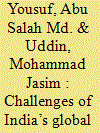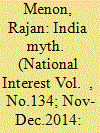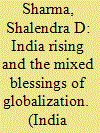|
|
|
Sort Order |
|
|
|
Items / Page
|
|
|
|
|
|
|
| Srl | Item |
| 1 |
ID:
134953


|
|
|
|
|
| Summary/Abstract |
While globalisation unleashes forces that the Indian State1 finds increasingly difficult to stop and contain, a variety of intermediate institutions has emerged in recent years ranging between a fully securitised State and a State integrated fully into the world economy. These obviously call new configurations of border and border economy into existence as much as contribute to the production of new and hitherto unknown political subjects. Border economy produces the community and not the other way round. Border trade is one of the many instrumentalities through which the flow of persons, goods and services is sought to be contained in order to help making the nation in the border. Ethnicity and ethnic identification serve as a technology for governing the unofficial trade and contributes to the production of ethnic subject. Besides, it is important to understand how a number of people eke out a living by taking advantage of differential pricing across the border. Thus, the labouring life of the subaltern has become an agent, and a moral community thus gets produced, bringing about, in the process, mutation in the dominant discourses of national security and functional integration.
|
|
|
|
|
|
|
|
|
|
|
|
|
|
|
|
| 2 |
ID:
136587


|
|
|
|
|
| Summary/Abstract |
India is emerging as a global economic power and expanding its military capabilities. Its maritime posture in the Indo-Pacific has made it an important stakeholder in the Asia-Pacific strategic ambiguity. The country is invited in almost all global forums and encouraged to play active role in the international affairs. These are some of the key indicators of India’s global emergence. By contrast, India is yet to take strong footholds in several global issues, while negotiating with international powers e.g. the USA and China. Some major challenges of the global emergence of India are its foreign policy predicaments, neighbourhood compulsions and China bogey, compulsions of energy import, limits of its soft power capabilities, internal security threats and domestic underdevelopment. In this context, the two important research questions of this paper are: which factors indicate India as an emerging global power? And, what are the challenges for India’s global emergence? The paper concludes that due to emerging economic and military power, India’s role in the international arena are increasing, but the country faces both internal and external challenges to project itself as a global power.
|
|
|
|
|
|
|
|
|
|
|
|
|
|
|
|
| 3 |
ID:
134738


|
|
|
|
|
| Summary/Abstract |
This article examines the determinants of government yields in India using weekly data from April 2001 through June 2012. The analysis covers treasury bills with residual maturity of 15–91 days and government securities of residual maturity 1, 5 and 10 years. The empirical estimates show that a long-run relationship exists between each of these interest rates and the policy rate, rate of growth of money supply, inflation, interest rate spread, foreign interest rate and forward premium. At the same time, the empirical results show that the relative importance of the determinants varies across the maturity spectrum. The normalised generalised variance decompositions suggest that the policy rate and the rate of growth of high powered money are more important in explaining the proportion of variation in shorter-term interest rates than the longer-term rates. The weight of the forward premium also diminishes as we move towards higher maturity interest rates. The inflation rate becomes relatively less important in explaining variations in the yields as the maturity of the security increases. The yield spread, on the other hand, is more important in explaining the longer-term rates. The results also show that a large proportion of the variation in the rates on the 5-year and 10-year government securities is attributed to the interest rate itself, suggesting that the unexplained variation may be a result of cyclical factors that are relatively more important for longer-term rates but are not captured by the yield spread and are omitted from the estimations in this article due to the high frequency of data employed here.
|
|
|
|
|
|
|
|
|
|
|
|
|
|
|
|
| 4 |
ID:
136818


|
|
|
|
|
| Summary/Abstract |
This article aims to present the effect of the new alternative energy revolution globally to the traditionally held petro-power and their fading influence in the global political arena, the effect on the export of variants of religious fundamentalism and an array of issues revolving around the OIL politics and diplomacy globally. The paper also presents a way forward for the Indian government to enhance the energy equation and ensure the energy security for the growing Indian economy.
|
|
|
|
|
|
|
|
|
|
|
|
|
|
|
|
| 5 |
ID:
134930


|
|
|
|
|
| Summary/Abstract |
Today India is considered to be a major player in the emerging global balance of power. It is also emerging as one of the centres of the modern global economy. One of the major aspects of India's foreign policy in the post-Cold War period is its increasing economic, political and strategic engagement with the Asia-Pacific region, or India's 'Look East Policy'. However, India's eastward expansion has not yet resulted in substantial strategic or economic relationship with New Zealand. There is ample scope for New Zealand to enhance this relationship, particularly in strategic and security co-operation, to deal with the emerging challenges from traditional and non-traditional sources in the region.
|
|
|
|
|
|
|
|
|
|
|
|
|
|
|
|
| 6 |
ID:
134500


|
|
|
|
|
| Summary/Abstract |
India's behavior in the global economy has transformed considerably, consistent with its embrace of economic globalization and deregulation since 1991. Until then, India had practiced a type of economic engagement that Stephen Krasner (1985) characterized as structural conflict. Its capacity to tax citizens was dismal. Its trade as proportion of gross domestic product (GDP) hovered around 16% in the 1980s, impeding growth. And, economic resources were redistributed authoritatively rather than through trade. India, like many developing countries, was locked in economic conflict with the West until the 1980s. Since then, it has embraced global economic integration, contributing to surging economic growth. An economy that grew at an average of 3.5% between 1956 and 1975 has grown at more than 6% since 1980 and over 7% since 2004. India is one of the fastest growing economies in the world after China, and the gap between the two countries is shrinking.
|
|
|
|
|
|
|
|
|
|
|
|
|
|
|
|
| 7 |
ID:
135217


|
|
|
|
|
| Summary/Abstract |
OVER THE last two decades, numerous books, articles and press commentaries have hailed India as the next global power. This flush of enthusiasm results partly from the marked acceleration in India’s economic growth rate following reforms initiated in 1991. India’s gross domestic product (GDP) grew at 6 percent per year for most of the 1990s, 5.5 percent from 1998 to 2002, and soared to nearly 9 percent from 2003 to 2007, before settling at an average of 6.5 percent until 2012.
|
|
|
|
|
|
|
|
|
|
|
|
|
|
|
|
| 8 |
ID:
134952


|
|
|
|
|
| Summary/Abstract |
India has been a major beneficiary of economic globalisation. Yet, integration into the global economy has also made India vulnerable to the unpredictable swings in market sentiment. Nevertheless, the ultimate effects of cross-border economic forces also depend on the robustness of domestic policies. Potential vulnerabilities such as disruption in trade or financial flows can be mitigated by sound macroeconomic policies. Although ‘licence raj’ and ‘export pessimism’ is now a thing of the past, India’s quasi-protectionist policies, coupled with the failure to deepen its integration into the global economy, have made the economy increasingly vulnerable to external forces—as seen when the United States Federal Reserve announced its decision to unwind its stimulus programme in mid-2013, resulting in deep sell-offs in emerging economies, especially India’s currency, bond and equity markets.
|
|
|
|
|
|
|
|
|
|
|
|
|
|
|
|
| 9 |
ID:
137018


|
|
|
|
|
| Summary/Abstract |
Based largely on speeches, statements and interviews of Prime Minister Jawaharlal Nehru—who dominated the foreign policy-making processes and held the portfolio of foreign minister throughout the 17 years of his prime ministership—this article examines initial Indian concerns, perceptions and policy towards the European Economic Community. It evaluates the key elements which influenced his thinking and evaluates Indian attempts to secure a viable trade arrangement with the Community during the Nehru era.
|
|
|
|
|
|
|
|
|
|
|
|
|
|
|
|
| 10 |
ID:
134957


|
|
|
|
|
| Summary/Abstract |
Millions of job seekers in South Asia, including many tribals, are forced by lack of local employment opportunities to migrate towards urban areas. This fieldwork-based study aims to understand specifically which factors influence job search processes among tribals from two states in India—Jharkhand and West Bengal. It examines their reasons for moving and factors on which job search depends, methods adopted in job search, the extent of different options and limitations because of the nature of jobs available and the skills levels of the people concerned. Based on these ethnographic findings, some policy concerns are raised in terms of monitoring of migration and protection of food security for tribal communities and other structurally disadvantaged rural people in South Asia.
|
|
|
|
|
|
|
|
|
|
|
|
|
|
|
|
| 11 |
ID:
134742


|
|
|
|
|
| Summary/Abstract |
India’s 12th Five-Year Plan (2012–13 to 2016–17) emphasises ‘faster, sustainable and more inclusive growth’. The GDP growth target for the Plan was initially fixed at 9 per cent and later revised to 8 per cent against the backdrop of significant contraction of domestic output during the first two years of the Plan period. The Plan document has set a target of achieving a 2 percentage point reduction in poverty per annum. However, the document has cautioned that achieving the revised growth target also needs special efforts and structural reforms in the economic, social and political systems. For the first time, the Planning Commission has proposed to work on ‘scenario planning’ for the 12th Plan. It has proposed three scenarios: ‘The Flotilla Advances’, ‘Muddling Along’ and ‘Falling Apart’. The main thrust of scenario analysis is to highlight the need for specific interventions in policy to achieve the goals of the Plan. Using the macroeconometric model developed by the National Council for Applied Economic Research (NCAER) in India, the study finds that GDP growth rate will decline significantly under the Falling Apart scenario compared with the other two scenarios. As a result, poverty reduction is expected to be marginal under this scenario. The Falling Apart scenario will also lead to an unsustainable fiscal and current account deficit situation over the medium term. The other important finding of the study is that investment in social infrastructure (education and health) and physical infrastructure would not only achieve higher economic growth but also sustain it in the long term and both infrastructures have a similar impact on growth.
|
|
|
|
|
|
|
|
|
|
|
|
|
|
|
|
| 12 |
ID:
134737


|
|
|
|
|
| Summary/Abstract |
This article addresses the issue of past and future types of monetary-fiscal coordination that can deliver inclusive growth and low inflation in the Indian context. After India’s Independence, monetary policy was subordinated to planned development and, therefore, implicitly directed at inclusion. But large areas of the economy were still not monetised, and the modern sector was small. So inclusion was about expanding the sphere of the modern economy. Once a populous emerging market (EM) crosses a critical threshold and high catch-up growth is established, higher labour mobility blurs the distinction between the formal and informal sectors. A macroeconomics of the aggregate economy becomes both necessary and feasible. Since monetary policy affects a larger part of the economy, it can directly affect inclusion by affecting the pace of job creation. But bottlenecks that raise costs, pushing up the price at which any level of output is available, can force monetary tightening. If fiscal policies are redesigned for active inclusion that expands human capacity, makes more productive labour available, and reduces wasteful distortions, monetary policy can better support the objective of inclusive growth. The change in the type and efficacy of government policies designed for inclusion required has become politically and technologically feasible.
|
|
|
|
|
|
|
|
|
|
|
|
|
|
|
|
| 13 |
ID:
134741


|
|
|
|
|
| Summary/Abstract |
In the aftermath of the global food and fuel price spikes, and the recent global financial crisis, understanding of external sector behaviour has become crucial. The transmission mechanism of external sector shocks to domestic macroeconomic variables is essential for undertaking relevant policies to mitigate the adverse impact of such shocks. Here an attempt has been made to review the theoretical and empirical issues relating to India’s external sector behaviour and to present a suitable analytical framework for macro modelling.
|
|
|
|
|
|
|
|
|
|
|
|
|
|
|
|
| 14 |
ID:
134959


|
|
|
|
|
| Summary/Abstract |
This article examines the role of producer organisations in improving service delivery to producers/farmers. It observes that access to technology and other farm advisory services for producers within a producer organisation or partner arrangement is much more effective than for non-partners. Perceptible changes occurred in terms of increase in net incomes for partners compared to non-partners, even though increases in yield were not always observed. Benefits arose mainly because of increase in market access, marketable surplus and bargaining power for producer organisations. Such encouraging findings support arguments for greater policy support to leverage the functioning of producer organisations for their sustenance and replication.
|
|
|
|
|
|
|
|
|
|
|
|
|
|
|
|
| 15 |
ID:
134739


|
|
|
|
|
| Summary/Abstract |
A structural vector autoregression (SVAR) model is proposed for analysing the impact of monetary policy stances on real variables in the Indian economy, in the context of its continuous exposure to global factors like oil price shocks and changes in global financial health. The empirical findings based on monthly data relating to the post-liberalisation period (April 1992–December 2012) suggest that contractionary monetary policy has had a considerable adverse impact on output for a year, which appears to be consistent with the prevailing economic outlook. But the same policy measure fuels inflation further for the first eight months in contrast to its expected decline, and the rise in inflation raises the issue of a ‘price puzzle’ in the Indian context. Monetary policy-induced exchange rate appreciation hampers industrial production due to outperformance of high import demand over export competitiveness and causes an increase in the average price level. Global factors like oil price shocks leave detrimental effects on output for a long time horizon of 10–12 months and raise inflation for nearly half a year, whereas an increase in the US federal funds rate results in a temporary decline in output growth of Indian industries
|
|
|
|
|
|
|
|
|
|
|
|
|
|
|
|
|
|
|
|
|